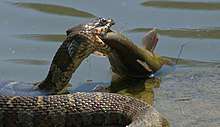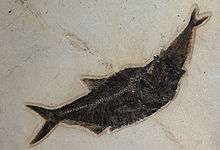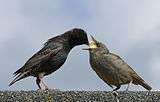Piscivore
A piscivore /ˈpɪsɪvɔːr/ is a carnivorous animal that eats primarily fish. Piscivorous is equivalent to the Greek-derived word ichthyophagous. Fish were the diet of early tetrapods (amphibians); insectivory came next, then in time, reptiles added herbivory.[1]
| Look up piscivore in Wiktionary, the free dictionary. |

Some animals, such as the sea lion and alligator, are not completely piscivorous, often preying on aquatic invertebrates or land animals in addition to fish, while others, such as the bulldog bat and gharial, are strictly dependent on fish for food. Humans can live on fish-based diets as can their carnivorous domesticated pets, such as dogs and cats. The name "piscivore" is derived from the Latin word for fish, piscis. Some creatures, including cnidarians, octopuses, squid, spiders, sharks, cetaceans, grizzly bears, jaguars, wolves, snakes, turtles, and sea gulls, may have fish as significant if not dominant portions of their diets.
The ecological effects of piscivores can extend to other food chains. In a study of cutthroat trout stocking, researchers found that the addition of this piscivore can have noticeable effects on non-aquatic organisms, in this case bats feeding on insects emerging from the water with the trout.[2]
There exists classifications of primary and secondary piscivores. Primary piscivores, also known as "specialists", shift to this habit in the first few months of their lives. Secondary piscivores will move to eating primarily fish later in their lifetime. It is hypothesized that the secondary piscivores' diet change is due to an adaptation to maintain efficiency in their use of energy while growing.[3]
Examples of extant piscivores
- Aquatic genet
- Flat-headed cat
- Bulldog bat
- Sea lion
- Fur seal
- Otter shrew
- European otter
- North American river otter
- American mink
- Fishing cat
- Amazon river dolphin
- Giant otter
- Bottlenose dolphin
- Harbor seal
- Osprey
- Merganser
- Penguin
- Bald eagle
- Arapaima
- Fish-eating bat
- Gharial
- Yellow-bellied sea snake
- African tigerfish
- Barracuda
- Giant trevally
- Alligator gar
- Lemon shark [4]
- Fishing spider
- Tiger
- Piranha[3]
- Bluefish[3]
Extinct and prehistoric piscivores
Numerous extinct and prehistoric animals are hypothesized to have been primarily piscivorous due to anatomy and/or ecology. Furthermore, some have been confirmed to be piscivorous through fossil evidence. This list includes specialist piscivores, such as Laganosuchus, as well as generalist predators, such as Baryonyx & Spinosaurus, found to have or assumed to have eaten fish.

- Baryonyx (an opportunistic predator that had a crocodile-like skull, and scales of the lepidotid fish Scheenstia have been found in a skeleton where the stomach should be)[5]
- Spinosaurus (close relative of Baryonyx, is hypothesized to have preyed on fish because of giant coelacanthids found in the same environment, and due to anatomical features, including a pressure-sensitive snout that could have detected movements of swimming prey)[5][6]
- Laganosuchus (flattened head suggests that it passively waited for fish to swim near its mouth in order to engulf them)[7]
- Pteranodon (remains of fish found in the beaks and stomach cavities of some specimens)
- Elasmosaurus (long neck, stereoscopicly positioned eyes, and long teeth are thought to be adaptations for stalking and trapping fish and other schooling animals)
- Thyrsocles (fossil specimen found with the stomach stuffed with the extinct herring Xyne grex)[8]
- Xiphactinus (a 4-meter-long specimen was found with a perfectly preserved skeleton of its relative, Gillicus, in its stomach)
- Diplomystus (a small relative of the herring, numerous fossils of individuals that died while trying to swallow other fishes, including smaller individuals of the same species, are known)
- Ornithocheirus (hypothesized to be piscivorous due to anatomy of its jaws and dentition)
- Titanoboa (multiple cranial and biochemical characteristics suggest it was primarily piscivorous)[9]
References
- Sahney, S., Benton, M. J. & Falcon-Lang, H. J. (2010). "Rainforest collapse triggered Pennsylvanian tetrapod diversification in Euramerica". Geology. 38 (12): 1079–1082. Bibcode:2010Geo....38.1079S. doi:10.1130/G31182.1.CS1 maint: multiple names: authors list (link)
- Rudman, Seth M.; Heavyside, Julian; Rennison, Diana J.; Schluter, Dolph (2016-12-01). "Piscivore addition causes a trophic cascade within and across ecosystem boundaries". Oikos. 125 (12): 1782–1789. doi:10.1111/oik.03204. ISSN 1600-0706.
- Hart, Paul (2002). Handbook of Fish Biology and Fisheries. 350 Main Street, Malden, MA 02148: Blackwell Publishing. pp. 267–283. ISBN 978-0632054121.CS1 maint: location (link)
- Bright, Michael (2000). The private life of sharks : the truth behind the myth. Mechanicsburg, PA: Stackpole Books. ISBN 978-0-8117-2875-1.
- Sereno, Paul C.; Beck, Allison L.; Dutheil, Didier B.; Gado, Boubacar; Larsson, Hans C. E.; Lyon, Gabrielle H.; Marcot, Jonathan D.; Rauhut, Oliver W. M.; Sadleir, Rudyard W.; Sidor, Christian A.; Varricchio, David D.; Wilson, Gregory P.; Wilson, Jeffrey A. (1998). "A long-snouted predatory dinosaur from africa and the evolution of spinosaurids". Science. 282 (5392): 1298–302. Bibcode:1998Sci...282.1298S. doi:10.1126/science.282.5392.1298. PMID 9812890.
- Dal Sasso, C.; Maganuco, S.; Cioffi, A. (26 May 2009). "A neurovascular cavity within the snout of the predatory dinosaur Spinosaurus". 1st International Congress on North African Vertebrate Palaeontology. Muséum national d'Histoire naturelle. Retrieved 22 September 2010.
- Devlin, Hannah (November 20, 2009). "Meet Boar, Rat and Pancake: the ancient, giant crocodiles found in Sahara". Times Online.
- David, Lore Rose. January 10, 1943. Miocene Fishes of Southern California The Society p 104-115
- Head, J.J; Bloch, J. I; Moreno-Bernal, J. (2013). "Cranial Osteology, Body Size, Systematics and Ecology of the giant Paleocene snake Titanoboa cerrejonensis". Vertebrate Paleontology: 140–141.
